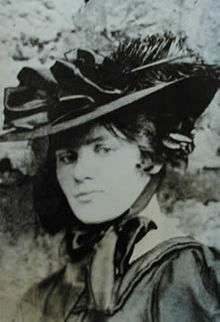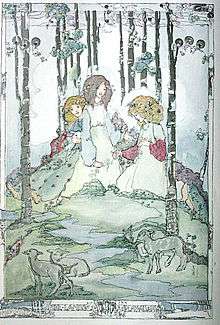Jessie M. King
Jessie Marion King (20 March 1875 – 3 August 1949) was a Scottish illustrator known for her illustrated children's books.[1] She also designed bookplates, jewellery and fabric, and painted pottery. King was one of the artists known as the Glasgow Girls.[2]
Jessie Marion King | |
|---|---|
 | |
| Born | Jessie Marion King 20 March 1875 |
| Died | 3 August 1949 (aged 74) |
| Nationality | Scottish |
| Education | Glasgow School of Art |
| Known for | Illustration, Design |
| Movement | Art Nouveau, Glasgow Style, Symbolism |
| Spouse(s) | E. A. Taylor |
Early life and education
King was born at the manse, New Kilpatrick, in Bearsden, Dunbartonshire, near Glasgow.[3] Her father was James Wat(t)ers King, a minister with the Church of Scotland, and her mother was Mary Anne Anderson. She received a strict religious education and was discouraged from becoming an artist. When King was very young, she would hide drawings she made in school for fear that her mother would tear them up.[4] Mary McNab, the family housekeeper, was a formative influence, and was regarded by King as her second mother.[5] King had a spiritual experience in Argyll as a teenager when she fell asleep on a hillside and felt the touch of fairies, in whose existence she continued to believe.[6]
Jessie M. King began training as an art teacher in 1891 at Queen Margaret College (Glasgow). In 1892 she entered the Glasgow School of Art. As a student, she received a number of awards, including her first silver medal from the National Competition, South Kensington (1898).
Career and work

King was made Tutor in Book Decoration and Design at Glasgow School of Art in 1899. She continued to teach until her marriage to E. A. Taylor in 1908, and she chose, against the grain, to keep her maiden name.[2]
King was influenced by the Art Nouveau of the period,[7] and her works correspond in mood with those of The Glasgow Four. Despite the influence of Art Nouveau, she was inspired to create unique designs where she did not literally translate the real world. "I would not copy designs," she said, "but insisted on drawing out of my head."[2] During her early period, she created detailed pen and ink illustrations on vellum.[4]
Most of King's earliest works involved illustration, but she also wrote books and was a skilled jewellery designer.[2] Her first published designs, and some people believe her finest, were for the covers of books published by Globus Verlag, Berlin, between 1899 and 1902. The publisher was a subsidiary company of the great Berlin department store, Wertheim's. The publisher, Georg Wertheim, wanted her to design "a range of items in the 'new Scottish Style.'"[2] In all she illustrated, wrote, decorated or designed the cover of more than 100 books and other publications.[8][9]
She made a Grand Tour of Germany and Italy in 1902 and was influenced by the works of Botticelli. In the same year her binding for "L'Evangile de L'Enfance" was awarded a gold medal in the International Exhibition of Modern Decorative Art, held in Turin. The accompanying certificate was made out to "Signor Jessie Marion King" because there was no provision for a prize to be won by a "Signora".[10] King became a committee member of the Glasgow Society of Artists (1903) and a member of the Glasgow Society of Lady Artists (1905). Her contribution to Art Nouveau peaked during her first exhibitions, Annan's Gallery in Glasgow (1907) and Bruton Street Galleries, London (1905).
In 1908 King and her husband moved to Salford where their only child, a daughter, Merle Elspeth, was born in 1909; Mary McNab joined the household, which enabled King to continue working.[3][5] In 1910 they moved on to Paris where Taylor had gained a professorship at Ernest Percyval Tudor-Hart's Studios. In 1911 King and Taylor opened the Sheiling Atelier School in Paris. Her works in Paris are considered as influential to the creation of the Art Deco movement. King and Taylor moved to Kirkcudbright in 1915 and continued to work there until her death.
King also decorated ceramics and worked with batik, which she is credited with introducing to Liberty's.[10] In 1924 she published How Cinderella Was Able to Go to the Ball, "A Brochure on Batik written and illustrated by Jessie M. King."[11]
King died at home in Kircudbright on 3 August 1949, following a heart attack. She was cremated at Kirkcudbright and her ashes were scattered at Minard, Argyll, at the church where Mary McNab was buried.[3][9]
Gallery
|
References
- Taylor, John Russell (1 December 2004). "Real Page Turners". Times (United Kingdom). Retrieved 24 February 2015.
- Burkhauser, Jude (1993). "Jessie M. King (1875-1949)". Glasgow Girls: Women in Art and Design 1880-1920. Edinburgh: Canongate Press, Plc. pp. 132–139. ISBN 0963698508.
- Marsh, Jan (2004). "King [married name Taylor], Jessie Marion (1875–1949), illustrator and designer". Oxford Dictionary of National Biography (online ed.). Oxford University Press. doi:10.1093/ref:odnb/38944. Retrieved 14 February 2020. (Subscription or UK public library membership required.)
- Ortakales, Denise (2002). "Jessie M. King". Women Children's Book Illustrators. Archived from the original on 8 November 2007. Retrieved 24 February 2015.
- "King, Jessie M. | Robbins Library Digital Projects". d.lib.rochester.edu. Retrieved 14 February 2020.
- King, Jessie M. (1984). The City of the West. Foreword by Anne Barren Skipwith. Polygon. ISBN 0904919862.
- Murdoch, W.G. Blaikie (December 1917), "British Illustrators", The American Magazine of Art, 9 (2): 54, JSTOR 23935248,
And it is [Aubrey Beardsley's] work in this lapidarian manner which has proved influential to Miss Jessie King and to Miss Annie French, whose craftsmanship, in various of her little pictures for old ballads, has a charm making every particle claim microscopic study.
- "Jessie M. King: Scottish Book Illustrator : Textualities". Retrieved 14 February 2020.
- "King, Jessie M. | Robbins Library Digital Projects". d.lib.rochester.edu. Retrieved 14 February 2020.
- Macmillan, Duncan (28 July 1999). "King's Evidence". The Scotsman. ProQuest 326710597.
- ""Contents of How Cinderella Was Able To Go to The Ball." | Robbins Library Digital Projects". d.lib.rochester.edu. Retrieved 14 February 2020.
Bibliography
- The Enchanted World of Jessie M. King by Colin White, Canongate Books, 1989, ISBN 0-86241-363-X
- A Guide to the Printed Work of Jessie M. King (1874-1949) by Colin White, British Library, 2007, ISBN 9780712349338.
- Birth Record (1875 King, Jessie Marion [Statutory Births 500/00 0066]) (Scotlands People)
- Marriage Record (1908 Taylor, Ernest A - King, Jessie Marion [Statutory Marriages 475/00 0028]) (Scotlands People)
- Death Record (1949 Taylor, Jessie Marion [Statutory Deaths 871/00 0022]) (Scotlands People)
- Birth Record (index England & Wales, Free BMD Birth Index, 1837-1915 Merle Elspeth Taylor)
External links
- Jessie M. King illustrations at Art Passions
- Jessie Marion King biography at the Gracefield Arts Centre in Dumfries, Scotland virtual representation of the Gracefield Arts Centre's Permanent Collection at exploreart.co.uk
- Jessie M. King: Scottish Book Illustrator
- Jessie M. King, Camelot Project, University of Rochester
- Jessie M. King at Library of Congress Authorities, with 7 catalogue records

